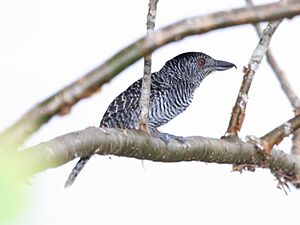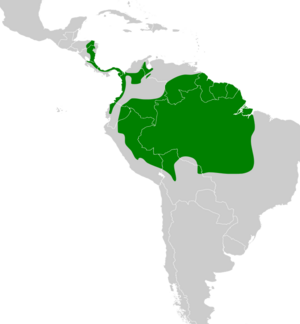Fasciated antshrike facts for kids
Quick facts for kids Fasciated antshrike |
|
|---|---|
 |
|
| Male in Panama | |
 |
|
| Female in Panama | |
| Conservation status | |
| Scientific classification | |
| Genus: |
Cymbilaimus
|
| Species: |
lineatus
|
 |
|
The fasciated antshrike (Cymbilaimus lineatus) is a cool type of bird. It belongs to a group called "typical antbirds." You can find this bird in Central America, starting from Honduras and going south. It also lives in almost every country in mainland South America, except for Argentina, Chile, Paraguay, and Uruguay.
Contents
About the Fasciated Antshrike Family
The fasciated antshrike has three main types, called subspecies. These are C. l. lineatus, C. l. fasciatus, and C. l. intermedius.
Long ago, another bird called the bamboo antshrike was thought to be a type of fasciated antshrike. But in the 1980s, scientists realized it was its own separate species. These two birds, the fasciated antshrike and the bamboo antshrike, are the only members of their bird group, which is called Cymbilaimus.
What Does the Fasciated Antshrike Look Like?
This bird is about 17 to 18 centimeters (7 inches) long. It weighs around 35 to 40 grams (1.2 to 1.4 ounces).
Male and female fasciated antshrikes look quite different. This is called sexual dimorphism. Both male and female birds have red eyes. They also have a strong bill (beak) with a hook at the end, much like a true shrike bird.
Adult males of the C. l. lineatus type have a black forehead and top of the head. They have a few very thin white stripes there. The rest of their body has thin black and white stripes.
Females of this type have a reddish-brown top of the head. Most of their body has thin dark brown and pale yellowish-brown stripes. Their tail also has dark brown and pale tan stripes.
Younger males look like adults but have wider white stripes. Males of the C. l. fasciatus type have strong black and white stripes on their forehead. These stripes stand out against their all-black head. Females of this type have brown and cinnamon stripes on their tail.
The C. l. intermedius type is similar to fasciatus. However, it has wider pale stripes on its tail. The colors of these two types can change a bit from bird to bird and as they get older. This means they can sometimes look very similar.
Where Do Fasciated Antshrikes Live?
The fasciated antshrike lives in different areas that are not connected. The C. l. fasciatus type lives the farthest north. Its home is separate from the larger area where the other two types live.
You can find C. l. fasciatus in southeastern Honduras, Nicaragua, and Costa Rica. It lives on the Caribbean side of these countries. It also lives in Panama on both the Caribbean and Pacific sides. This type continues into Colombia, northwestern Venezuela, and down the Pacific side into northwestern Ecuador.
The C. l. intermedius type lives from southern Colombia and Venezuela. It goes south through eastern Ecuador and eastern Peru into Bolivia. From there, it spreads east into parts of Amazonian Brazil.
The C. l. lineatus type lives in eastern Venezuela, Guyana, Suriname, and French Guiana. It also lives in Amazonian Brazil, north of the Amazon River.
Fasciated Antshrike Habitat
This bird makes its home in evergreen forests. This includes both old, untouched forests and newer, regrowing forests. It prefers lowlands and the lower parts of the Andes mountains.
In Central America, it often lives in areas with new plant growth and thick bushes. In other places, it lives inside the forest but also near the forest edge. Everywhere it lives, it loves areas with tangled vines and thick plants in the middle part of the forest.
It usually lives below 400 meters (1,300 feet) in Honduras. In most other places, it lives below 800 meters (2,600 feet). It can be found as high as 1,200 meters (3,900 feet) in Brazil and Costa Rica. In Colombia, it reaches 1,400 meters (4,600 feet). In Ecuador and Peru, it's usually below 1,000 meters (3,300 feet), but sometimes up to 1,500 meters (4,900 feet) in Peru. In Venezuela, it can go up to 1,300 meters (4,300 feet).
The fasciated antshrike and the bamboo antshrike live in some of the same places. However, the bamboo antshrike usually lives at higher elevations.
Fasciated Antshrike Behavior
Movement
Scientists believe the fasciated antshrike stays in the same area all year round. It does not migrate.
Feeding Habits
The fasciated antshrike mainly eats large insects. It also eats other small creatures like spiders. Sometimes, it will eat small lizards, frogs, and a little bit of fruit.
It usually looks for food alone or with a partner. Sometimes, it joins groups of different bird species that are feeding together. It typically searches for food in tangled vines and near tree trunks. It usually feeds between 5 and 20 meters (16 to 66 feet) above the ground. However, it will sometimes go lower.
The bird hops slowly through the plants. It catches its prey by reaching out, lunging, or making short flights from a branch. It also sometimes follows army ants. These ants stir up insects and other small animals, making them easier for the antshrike to catch. But the antshrike doesn't rely only on army ants for food.
Reproduction and Life Cycle
The breeding season for the fasciated antshrike changes depending on where it lives. It is from April to June in Costa Rica. In Amazonian Brazil, it's from July to November. Young birds that had just left the nest were seen in the Guianas in September and October.
Its nest is shaped like a cup. It is made from plant and fungus fibers. The nest is attached by its edges to a fork in a tree branch. It is usually placed 2 to 10 meters (7 to 33 feet) above the ground. The nest is often hidden by leaves.
A female usually lays two eggs. The eggs are creamy white with spots that can be lilac or brownish-green. Both parents sit on the eggs during the day to keep them warm. The female sits on them alone at night. We don't know exactly how long the eggs take to hatch or how long it takes for the young birds to leave the nest.
Vocalization
The fasciated antshrike's song is a slow, sad series of 3 to 10 whistles. The notes are longer than the pauses between them. The notes in the middle are sometimes longer and a bit higher pitched. People have described the notes as sounding like "weh." One person wrote the song as "cü-ü,cü-ü, cü-ü..." and another as "weeo wEEo wEEo weeo."
The bird also makes calls, including a sound like a "rattle-like chatter." It also makes a sad, downward-sliding whistle. Sometimes, these calls are mixed together in a series. Because this bird usually stays high up in thick plants, you are more likely to hear it than to see it.
Conservation Status
The IUCN (International Union for Conservation of Nature) has said that the fasciated antshrike is a species of "Least Concern." This means it is not currently in danger of disappearing.
It lives across a very large area. There are at least 500,000 adult birds, but their numbers are thought to be slowly going down. No immediate threats have been found that would put the species in danger.
The bird is considered common in most places it lives. However, it is rare to uncommon in Honduras and some parts of Costa Rica. Its home includes many protected areas. It also lives in "vast areas of unprotected but still intact suitable habitat," especially in the Amazon Basin and Guiana regions.


